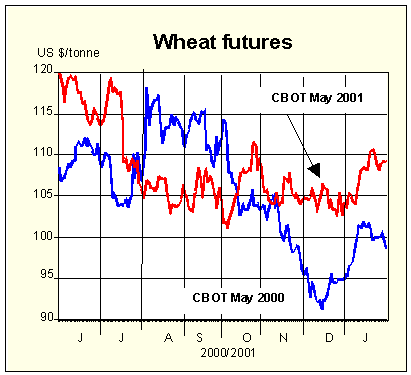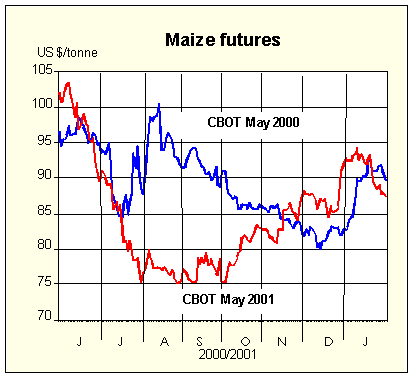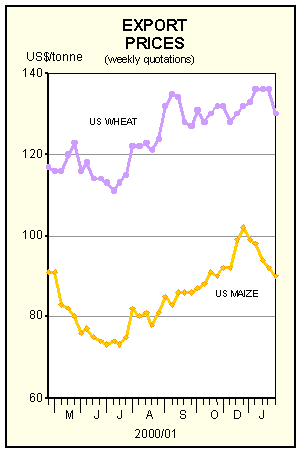


Overall, during the first half of the 2000/01 marketing season (July-December), international wheat prices moved higher, reflecting stronger commercial import demand and the expectation of lower carry-over stocks in major exporting countries. The rise in wheat prices slowed in the run-up to the holiday period in late December, as a result of reduced purchasing activity and downward pressure from the main harvesting season in southern hemisphere. In January, the US wheat No. 2 (HRW, fob) averaged US$134 per tonne, some US$3 per tonne more than in October 2000 and as much as US$23 per tonne, or 17 percent, above the previous year. The new Argentine wheat crop averaged US$120 per tonne in January, down US$3 per tonne on pre-Christmas values, but up US$27 per tonne, or 23 percent, from the corresponding period last year. While the volume of world trade is forecast to expand slightly this season, competition among major exporters for market share combined with large export supplies, also among a number of non-traditional exporters, could restrain any significant increase in international wheat prices in the coming months.
| 2001 | 2000 | ||
| Jan. | Oct. | Jan. | |
| (. . . . . . US$/tonne . . . . . .) | |||
| United States | |||
| Wheat 1/ | 134 | 131 | 111 |
| Maize | 95 | 85 | 93 |
| Sorghum | 104 | 92 | 91 |
| Argentina 2/ | |||
| Wheat | 120 | 123 | 93 |
| Maize | 84 | 76 | 93 |
| Thailand 2/ | |||
| Rice white 3/ | 187 | 191 | 244 |
| Rice, broken 4/ | 134 | 136 | 159 |
In the futures market, the supply pressure continued to weigh on prices and the near-by wheat futures ended the third week in January slightly weaker than a month earlier. In recent weeks, May prices for the soft red winter wheat contracts at the Chicago Board of Trade (CBOT) also weakened, although they were generally higher than the corresponding period a year ago. Given the present indications, any strong recovery in prices is difficult to envisage for at least another season.
International maize prices remained below 1999 levels through November 2000 but in December they rose sharply before starting to decline again. In January, the US maize export prices averaged US$95 per tonne, up

US$10 per tonne from October 2000 and US$2 per tonne higher than in January 2000. Overall, during the first half of the current marketing season, maize prices averaged around US$83 per tonne, compared to US$89 per tonne in the comparable period last season. The fundamental reason behind weak maize prices in recent years has been large supplies among exporting countries. Over the past few months, large sales from China and concerns over the export of the genetically modified (GM) maize from the United States, following the Starlink scare, put further downward pressure on US export prices. The controversial problem surrounding the sales of Starlink maize, which was not approved for human consumption in the United States, was raised when traces of this GM maize were found in Japan in October 1999. Considering that Japan is the largest importer of maize from the United States, uncertainty over future maize sales from the United States to Japan weakened prices further. In January, maize prices in the CBOT futures market also weakened and May contracts were quoted at US$86 per tonne, pointing to a drop of around US$6 per tonne since October and a decline of US$4 per tonne from the corresponding period last year. The recent decline in prices was also driven by the expectation of a likely resumption in large sales from China, especially in the light of further evidence of GM maize in Japan (and lately also in the Republic of Korea). Against this background and given the continuing large supply pressure, any significant price recovery over the next few months seems unlikely. Stronger prices could only be expected if this season's ending stocks were to fall below the current expected levels and/or in the event of a notable cut back in 2001 production.
The year 2000 ended with the lowest rice price recorded since 1987. On an annual basis, the FAO Export Price Index for Rice (1982-84=100) averaged 98 points in 2000, down from 114 in 1999. Although prices were weak for all types of rice, low quality rice was the most affected with the 2000 average index 19 points lower than that in 1999.

Rice quotations resumed their downward slide through November and December 2000, after a short-lived recovery in October in reaction to the weather problems which hampered shipping activities in Viet Nam. The FAO Export Price Index averaged 95 points in January 2001, down from the 97 points in October 2000. The price of high quality Thai 100% B rice, which had risen to US$191 per tonne in October, was down to US$187 in January 2001, depressed by the arrival of the new Thai crop on the market. By contrast, the price of high quality US No. 2/4 percent broken rice was sustained during the last quarter of 2000 by Government purchases for food aid. As a result, they reached an annual high of US$294 per tonne in November. Although prices fell to US$291 in January 2001, they surpassed by about US$20 the January 2000 quotation. The price of lower quality, fully broken rice (Thai A1 Super) dropped in January 2001 by two point to US$134 from October last year. However, at that level, they were up by US$4 and US$3 from November and December 2000 respectively, when prices dipped to the lowest levels since 1987.
Barring any unexpected shock, prices are likely to resume a downward trend with the arrival, in February-March, of new rice crops from exporters in the southern hemisphere and from Viet Nam. Moreover, the policy measures under consideration in India, to boost exports, and in Indonesia, Malaysia and Nigeria, to raise import restrictions, would all contribute, if effectively implemented, to an aggravation of the price weakness that characterized the international rice market in 2000.
